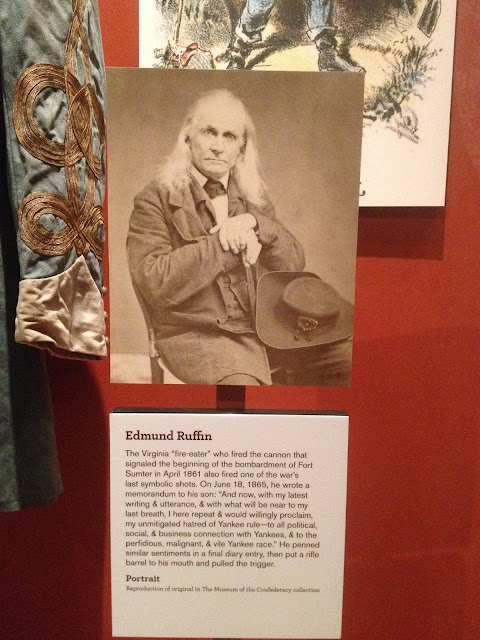General Robot E. Lee, in his best uniform for the surrender signing ceremony, greets a visitor to the Civil War Museum.
The ceremonial sword taken to the surrender ceremony by General Lee is also on display.
The museum does a magnificent job of weaving little known stories into the well known details of the Civil War. For example, under the surrender conditions, officers were allowed to keep their sidearms, and all troops were allowed to keep their horses if they previously owned them. Lee insisted that his men be given the tools to start life anew when they returned home.
Edward Ruffin, the man who fired the first shot of the Civil War at Ft. Sumter on April 10, 1861, also fired one of the last shots of the war. His fiery demeanor was legendary, and after writing a last entry in his diary telling of "his unmitigated hatred of Yankee rule", he put a rifle barrel in his mouth and pulled the trigger.
A great many Confederate families escaped the turmoil of the Reconstruction Period and fled to Canada, Mexico, and South America, where their descendants still live.
After the war, General Lee counseled Southerners to reconcile themselves to peace and unification. Privately, however, he resented Reconstruction policies. He became president of Washington College, later renamed Washington and Lee College, in Lexington, Virginia, and applied for a pardon that was not granted for over a hundred years. He suffered a stroke and died on October 12, 1870, and was buried at Washington and Lee College.
General Grant, of course, became president of the United States. He was a national hero whose reputation rested not only on his military victories, but also on his statesmanship at Appomattox. A lifetime of good whiskey and bad cigars contributed to his death from throat cancer on July 23, 1885.
A prosthetic arm created for a Confederate soldier was very primitive compared to todays sophisticated devices! This arm was only worn by its owner on special occasions because he said it got in the way more than it was worth.
Joseph Tyler Johnson posed for a photographer as a young soldier and again as an old soldier with a disfiguring facial wound. Johnson enlisted in April, 1861, and was shot through the face in May, 1864. He was active, as were so many Confederate veterans, in various commemorative veterans organizations.
The Appomattox Court House Historical Park encompasses the remains of the town of Appomattox Court House. Original named Clover Hill, it was renamed when the county of Appomattox was formed in 1845. Several of the original buildings remain, as well as the remains of the Lynchburg-Richmond Road. This is the road that both Lee and Grant rode their horses on for their historic meeting at the McLean House.
It is said that the Civil War began in Wilmer McLean's backyard, and ended in his parlor. Mr. McLean lived in Manassas, Virginia, near the First Battle of Bull Run, which was the first major battle of the war. He moved his family to Appomattox, thinking that it would be safer. Four years later, Lt. Col. Charles Marshall of Lee's staff was riding through town looking for a suitable site for the surrender meeting. Seeing McLean in the yard, preparing for a morning walk, he stopped to ask about an appropriate place. Mr. McLean offered the use of his parlor, and the rest is history.
A commemorative painting of the meeting between Lee and Grant is eerily recreated by the furnishings in the parlor today.
When the sun is low and the moon is high, and if the cicadas are very quiet, if you listen very carefully you will hear the sound of horses hooves galloping across the fields as General Lee and Traveller continue to search for a way of escape.
The inevitable happened here in Appomattox, Virginia.


















No comments:
Post a Comment